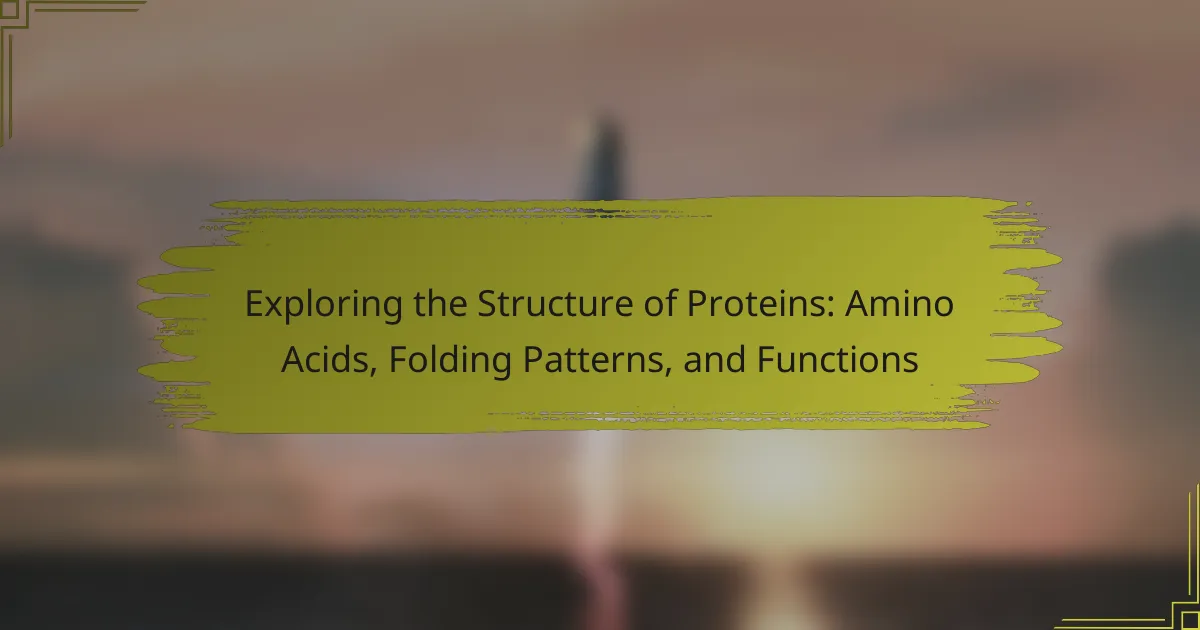
What are Proteins and Why are They Important?
Proteins are large, complex molecules made up of long chains of amino acids. They play critical roles in the body, including building and repairing tissues. Proteins are essential for the production of enzymes and hormones. They also support immune function and transport molecules within cells. The human body contains thousands of different proteins, each with unique functions. For example, hemoglobin is a protein that carries oxygen in the blood. The structure of proteins is determined by the sequence of amino acids, which influences their function. Therefore, proteins are vital for overall health and biological processes.
How are Proteins Defined in Biological Terms?
Proteins are defined as large, complex molecules made up of amino acids. They perform essential functions in living organisms, including catalyzing metabolic reactions, replicating DNA, and transporting molecules. Proteins are composed of one or more long chains of amino acids, which are linked by peptide bonds. The sequence of amino acids determines a protein’s unique structure and function. There are 20 different amino acids that can be combined in various sequences to form proteins. The specific arrangement of these amino acids leads to the protein’s 3D shape, which is crucial for its function. Proteins can also undergo modifications after synthesis, influencing their activity and interactions within the cell. This definition is supported by extensive research in biochemistry and molecular biology, highlighting the critical role of proteins in cellular processes.
What are the Key Characteristics of Proteins?
Proteins are large, complex molecules essential for various biological functions. They are made up of long chains of amino acids, which are linked by peptide bonds. The sequence of amino acids determines a protein’s unique structure and function. Proteins can adopt multiple folding patterns, including alpha-helices and beta-sheets, which contribute to their stability and functionality. They play critical roles in catalyzing biochemical reactions, providing structural support, and facilitating communication within and between cells. Proteins can also be classified by their shape, such as globular or fibrous, which influences their specific functions. Additionally, proteins can undergo modifications, such as phosphorylation, which can alter their activity and interactions. These characteristics underscore the importance of proteins in biological systems and their diverse roles in life processes.
How do Proteins Contribute to Cellular Functions?
Proteins contribute to cellular functions by acting as enzymes, structural components, and signaling molecules. Enzymes facilitate biochemical reactions, increasing reaction rates within cells. For example, lactase breaks down lactose into glucose and galactose, aiding digestion. Structural proteins, like collagen, provide support and shape to cells and tissues. Signaling proteins, such as insulin, regulate cellular processes by transmitting signals between cells. Additionally, proteins can transport molecules across cell membranes, ensuring nutrient uptake and waste removal. Their diverse roles are essential for maintaining cellular homeostasis and overall organism health.
What Role do Proteins Play in Living Organisms?
Proteins play crucial roles in living organisms by serving as enzymes, structural components, and signaling molecules. They catalyze biochemical reactions, facilitating essential metabolic processes. Enzymes, which are proteins, speed up reactions by lowering activation energy. Proteins also form the structural framework of cells and tissues, such as collagen in connective tissues and keratin in hair and nails. Additionally, proteins function in cell signaling, transmitting messages between cells and regulating biological processes. For instance, insulin is a protein that regulates glucose levels in the blood. Overall, proteins are fundamental to the functioning and maintenance of life, underpinning various biological activities.
Why are Proteins Considered the Building Blocks of Life?
Proteins are considered the building blocks of life because they are essential for the structure, function, and regulation of the body’s cells and organs. Composed of long chains of amino acids, proteins perform a vast array of functions. They act as enzymes, facilitating biochemical reactions. Proteins also provide structural support in cells and tissues, such as collagen in connective tissues. Additionally, proteins play a crucial role in the immune response as antibodies. The diversity of protein functions stems from the sequence and arrangement of amino acids, which determines their specific shapes and activities. This fundamental role in biological processes underscores the importance of proteins in all living organisms.
How do Proteins Influence Growth and Repair?
Proteins are essential for growth and repair in the body. They serve as building blocks for tissues, muscles, and organs. Proteins facilitate the synthesis of new cells, promoting growth during childhood and healing after injury. They also play a crucial role in the regeneration of damaged tissues. For example, collagen, a protein, is vital for skin and bone repair. Additionally, enzymes, which are proteins, accelerate biochemical reactions necessary for cellular repair. Studies show that adequate protein intake supports muscle recovery and overall health.

What are Amino Acids and How do They Relate to Proteins?
Amino acids are organic compounds that serve as the building blocks of proteins. They link together in specific sequences to form polypeptides, which then fold into functional proteins. There are 20 standard amino acids, each with a unique side chain that determines its properties. The sequence and composition of amino acids in a protein dictate its structure and function. Proteins play critical roles in biological processes, including catalyzing reactions and providing structural support. The genetic code in DNA specifies the arrangement of amino acids in proteins. This relationship underscores the importance of amino acids in the synthesis and functionality of proteins.
What are the Different Types of Amino Acids?
There are 20 different types of amino acids that are commonly found in proteins. These amino acids can be categorized into three groups: essential, non-essential, and conditional amino acids. Essential amino acids must be obtained through diet, as the body cannot synthesize them. Non-essential amino acids can be produced by the body. Conditional amino acids are usually not essential but may become essential during stress or illness. Examples of essential amino acids include leucine and valine. Non-essential amino acids include alanine and aspartic acid. Conditional amino acids include arginine and glutamine. This classification helps in understanding the roles of amino acids in protein synthesis and overall health.
How do Essential and Non-Essential Amino Acids Differ?
Essential amino acids cannot be synthesized by the body and must be obtained through diet. Non-essential amino acids can be produced by the body. There are nine essential amino acids, including leucine and lysine. In contrast, there are eleven non-essential amino acids, such as alanine and aspartic acid. Essential amino acids play a crucial role in protein synthesis and overall health. Non-essential amino acids support various metabolic processes but are not required from food sources. This distinction is fundamental in nutrition and health.
What are the Functions of Amino Acids in Protein Synthesis?
Amino acids serve as the building blocks of proteins during protein synthesis. They link together through peptide bonds to form polypeptide chains. Each amino acid has a specific role based on its unique side chain. This sequence of amino acids determines the protein’s structure and function. The genetic code in mRNA dictates the order of amino acids. Ribosomes facilitate the translation of mRNA into a polypeptide chain. Transfer RNA (tRNA) transports amino acids to the ribosome. The proper arrangement of amino acids is crucial for the protein’s biological activity.
How do Amino Acids Link to Form Proteins?
Amino acids link to form proteins through peptide bonds. A peptide bond is a covalent bond formed between the carboxyl group of one amino acid and the amino group of another. This process occurs during a dehydration synthesis reaction, where a molecule of water is released. The sequence of amino acids determines the protein’s structure and function. Proteins are made up of long chains of amino acids, typically consisting of 20 different types. The specific order of these amino acids is dictated by the genetic code. This linking process is essential for creating functional proteins necessary for various biological processes.
What is the Process of Peptide Bond Formation?
Peptide bond formation is the process where two amino acids link together. This occurs through a dehydration synthesis reaction. During this reaction, the carboxyl group of one amino acid reacts with the amino group of another. A molecule of water is released as a byproduct. The resulting bond is a covalent bond known as a peptide bond. This bond creates a dipeptide, consisting of two amino acids. Peptide bonds can further link to form polypeptides and proteins. Peptide bonds are stable and require specific enzymes for breakdown.
How do Amino Acid Sequences Determine Protein Structure?
Amino acid sequences determine protein structure through the specific order of amino acids that dictate folding patterns. Each protein is composed of a unique sequence of amino acids. This sequence influences how the protein folds into its three-dimensional shape. The folding is driven by interactions among the amino acids, such as hydrogen bonds, ionic bonds, and hydrophobic interactions. These interactions stabilize the protein’s structure and are crucial for its function. For example, misfolded proteins can lead to diseases like Alzheimer’s. The primary structure, which is the linear sequence of amino acids, ultimately determines the higher levels of protein structure: secondary, tertiary, and quaternary. Thus, the amino acid sequence is fundamental to the overall architecture and functionality of proteins.

What are the Folding Patterns of Proteins?
Folding patterns of proteins refer to the specific three-dimensional shapes that proteins adopt. These patterns are crucial for protein function and stability. Proteins typically fold into four main levels of structure: primary, secondary, tertiary, and quaternary. The primary structure is the linear sequence of amino acids. Secondary structures include alpha helices and beta sheets formed by hydrogen bonding. Tertiary structure is the overall three-dimensional shape formed by interactions between side chains. Quaternary structure involves the assembly of multiple polypeptide chains. The folding process is guided by the sequence of amino acids and is essential for proper biological function. Misfolded proteins can lead to diseases such as Alzheimer’s and cystic fibrosis.
What are the Levels of Protein Structure?
The levels of protein structure are primary, secondary, tertiary, and quaternary. Primary structure refers to the linear sequence of amino acids in a polypeptide chain. Secondary structure involves the formation of alpha helices and beta sheets through hydrogen bonding. Tertiary structure is the three-dimensional shape formed by the folding of the polypeptide chain. Quaternary structure occurs when multiple polypeptide chains assemble into a functional protein complex. Each level of structure is crucial for the protein’s overall function and stability.
How do Primary, Secondary, Tertiary, and Quaternary Structures Differ?
Primary, secondary, tertiary, and quaternary structures of proteins differ in their levels of organization. The primary structure is the linear sequence of amino acids in a polypeptide chain. This sequence determines the protein’s unique characteristics. The secondary structure refers to local folding patterns, such as alpha helices and beta sheets, stabilized by hydrogen bonds. Tertiary structure describes the overall three-dimensional shape formed by the entire polypeptide chain, driven by interactions among side chains. Quaternary structure involves the assembly of multiple polypeptide chains into a functional protein complex. Each level of structure is crucial for the protein’s function, with alterations potentially leading to loss of activity.
What Factors Influence Protein Folding?
Protein folding is influenced by several key factors. These include the amino acid sequence of the protein, which determines its primary structure. The chemical properties of the amino acids, such as polarity and charge, affect interactions during folding. Environmental conditions like temperature and pH also play critical roles. Chaperone proteins assist in proper folding by preventing misfolding and aggregation. Additionally, the presence of post-translational modifications can alter folding pathways. These factors collectively ensure that proteins achieve their functional three-dimensional structures.
Why is Protein Folding Important for Function?
Protein folding is crucial for the proper function of proteins. The specific three-dimensional shape of a protein determines its functionality. Misfolded proteins can lead to diseases such as Alzheimer’s and cystic fibrosis. Proper folding allows proteins to interact with other molecules correctly. Each protein’s unique sequence of amino acids dictates its folding pattern. The correct conformation enables proteins to perform their biological roles efficiently. For instance, enzymes require specific shapes to catalyze reactions. Therefore, protein folding is essential for maintaining cellular health and function.
How does Misfolding Affect Protein Function?
Misfolding negatively impacts protein function by altering its three-dimensional structure. Proteins rely on specific folding patterns to perform their biological roles. When misfolded, proteins may lose their functional capabilities. This can lead to diseases such as Alzheimer’s and Parkinson’s, where aggregates form due to misfolded proteins. Misfolded proteins often become insoluble and accumulate in cells. The accumulation disrupts cellular processes and can lead to cell death. Studies have shown that even a single misfolded protein can trigger a cascade of misfolding in others. Therefore, proper protein folding is essential for maintaining cellular health and function.
What are the Consequences of Protein Misfolding in Diseases?
Protein misfolding can lead to various diseases, including neurodegenerative disorders. Misfolded proteins often aggregate, forming toxic structures. These aggregates can disrupt cellular function and lead to cell death. Diseases like Alzheimer’s and Parkinson’s are directly linked to protein misfolding. In Alzheimer’s, amyloid-beta plaques accumulate due to misfolding. In Parkinson’s, alpha-synuclein forms aggregates called Lewy bodies. Additionally, misfolded proteins can trigger immune responses. This can result in inflammation and further tissue damage. Overall, protein misfolding has severe consequences for cellular health and function.

How do Proteins Function in Biological Systems?
Proteins function in biological systems as essential molecules that perform a variety of tasks. They act as enzymes, catalyzing biochemical reactions to facilitate cellular processes. Proteins also provide structural support, forming the framework of cells and tissues. They play critical roles in transport, moving substances across cell membranes and within organisms. Proteins are involved in signaling, transmitting messages between cells and within cells. They also contribute to immune responses, identifying and neutralizing pathogens. The diverse functions of proteins arise from their complex structures, which are determined by the sequence of amino acids. Each protein’s unique shape enables it to interact specifically with other molecules. This specificity is crucial for maintaining the proper functioning of biological systems.
What are the Various Functions of Proteins?
Proteins serve multiple essential functions in biological systems. They act as enzymes, catalyzing biochemical reactions crucial for life. Proteins also provide structural support to cells and tissues, forming components like collagen and keratin. Additionally, proteins play a key role in transport, moving molecules across cell membranes or within the bloodstream, such as hemoglobin transporting oxygen. They are involved in immune responses, identifying and neutralizing pathogens. Proteins also facilitate communication within and between cells through signaling pathways. Furthermore, they store nutrients, as seen in casein in milk and ovalbumin in egg whites. Each of these functions is vital for maintaining homeostasis and supporting various physiological processes.
How do Enzymes Act as Biological Catalysts?
Enzymes act as biological catalysts by accelerating chemical reactions in living organisms. They lower the activation energy required for reactions to occur. This allows reactions to proceed more quickly and efficiently. Enzymes achieve this by binding to substrates, forming an enzyme-substrate complex. This complex stabilizes the transition state, making it easier for the reaction to occur. Enzymes are specific, meaning each type catalyzes a particular reaction or type of reaction. For example, amylase catalyzes the breakdown of starch into sugars. The efficiency of enzymes is critical for various biological processes, including metabolism and DNA replication. Studies have shown that enzymes can increase reaction rates by up to a million times compared to uncatalyzed reactions.
What Role do Structural Proteins Play in Cells?
Structural proteins provide support and shape to cells. They are essential for maintaining cellular integrity and overall structure. Common examples include collagen in connective tissues and keratin in hair and nails. These proteins form fibrous structures that resist deformation. They also play a role in cellular signaling and interactions. Structural proteins are involved in the formation of cytoskeleton elements, which help organize cellular components. Their presence is crucial for tissue strength and elasticity. Research shows that deficiencies in structural proteins can lead to various diseases, highlighting their importance in cellular function.
How do Proteins Interact with Other Molecules?
Proteins interact with other molecules primarily through specific binding sites. These sites allow proteins to recognize and attach to various ligands, such as substrates, hormones, or other proteins. The interactions often involve non-covalent forces like hydrogen bonds, ionic bonds, and hydrophobic interactions. Such binding is crucial for many biological processes, including enzyme catalysis and signal transduction. For example, enzymes bind to substrates to facilitate chemical reactions. Additionally, protein-protein interactions are vital for forming complexes that perform specific cellular functions. The specificity of these interactions is determined by the protein’s three-dimensional structure, which is shaped by its amino acid sequence. This structural arrangement enables proteins to achieve their functional roles in biological systems.
What is the Significance of Protein-Protein Interactions?
Protein-protein interactions are crucial for many biological processes. They facilitate cellular communication, signaling pathways, and structural integrity. These interactions enable proteins to form complexes that perform specific functions. For instance, enzymes often require multiple proteins to work together to catalyze reactions. Additionally, protein-protein interactions are essential for the regulation of gene expression. Studies show that disruptions in these interactions can lead to diseases, including cancer and neurodegenerative disorders. Understanding these interactions helps in drug development and therapeutic strategies.
How do Proteins Bind to Ligands and Receptors?
Proteins bind to ligands and receptors through specific interactions. These interactions often involve non-covalent bonds such as hydrogen bonds, ionic bonds, and hydrophobic interactions. The binding site on a protein is typically shaped to fit the ligand or receptor. This specificity allows proteins to recognize and interact with particular molecules.
When a ligand binds, it can induce a conformational change in the protein. This change can activate or inhibit the protein’s function. For example, in enzyme-substrate interactions, the binding of the substrate can enhance the enzyme’s catalytic activity.
Research shows that the affinity of a protein for its ligand can vary based on environmental factors such as pH and temperature. Understanding these binding mechanisms is crucial for drug design and therapeutic interventions.
What are Best Practices for Studying Protein Structure and Function?
Best practices for studying protein structure and function include using techniques like X-ray crystallography and NMR spectroscopy. X-ray crystallography provides high-resolution structures of proteins, revealing atomic details. NMR spectroscopy allows for studying proteins in solution, offering insights into dynamics and conformational changes. Cryo-electron microscopy is also valuable for large complexes, providing structural information at near-atomic resolution.
Utilizing computational methods, such as molecular dynamics simulations, helps predict protein behavior over time. Bioinformatics tools can analyze sequence data to infer structure-function relationships. Experimental validation of predictions is crucial for accuracy. Collaborating with interdisciplinary teams enhances the research quality and breadth of understanding.
These practices are supported by historical advancements in structural biology, leading to significant discoveries in protein functions and interactions.
Proteins are large, complex molecules composed of amino acids that play essential roles in biological systems, including catalyzing reactions, providing structural support, and facilitating communication. This article explores the structure of proteins, detailing the significance of amino acids, the various folding patterns, and the diverse functions proteins perform within living organisms. Key topics include the definition and characteristics of proteins, the importance of amino acids in protein synthesis, the levels of protein structure, and the consequences of protein misfolding. Understanding these elements is crucial for comprehending how proteins contribute to cellular functions and overall health.
